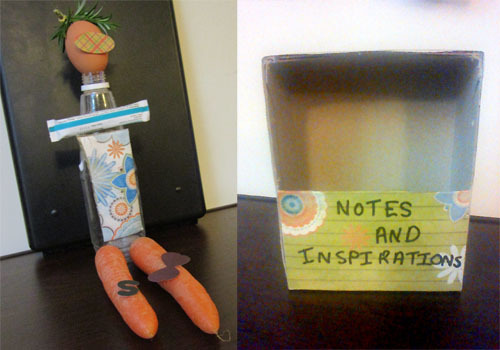Writing With Mobility Issues: How to Draft a Novel

We’re getting ready for Camp NaNoWriMo this July! This month, we’re talking to Wrimos who have tailored the Camp format to suit their writing habits. Today, participant Karen Haakma shares how to write a draft of your novel when some of the more commonly prescribed methods don’t work for you:
Meet Mackley. He has spiky hair, his forehead is wider than his chin, and his right limbs are shorter than his left. He has no fashion sense. A very indecisive dreamer, he hides it beneath a carapace of dependability and loyalty.
Mackley would never have existed if I had followed one of the more “traditional” formulas for planning a novel: “Go to the nearest mall / architecturally interesting building / sports game. Take multiple notebooks. Ask yourself screes of questions about what and who you see / hear / taste / smell / touch. Answer each one thoroughly in longhand. When you get home, transfer everything to index card. Lay them on the floor. Stand up. Examine the layout. Get down again and move the cards around. Stand up. Lather, rinse, repeat, until you’re satisfied with the result.”
This method presumes I can move around freely and read my handwriting on a 10x5 cm card from a standing distance. I can’t do either. Heck, I can hardly read my writing when it’s sitting on my wheelchair tray less than half a meter from my nose. It also presumes I can leave my home independently, and that wheelchair access is the norm. I can’t, and it isn’t.
So, should I give up because I have mobility issues and staring at pages of text leaves me lost and confused? Should you?
No. Not yet. At least try these tips first:
1. Identify your abilities.Can you:
Draw, paint, or sculpt?Cut, glue, staple, or tape?
Take photos?
Work a remote or a mouse?
Taking stock of what you are able to do can help you figure out the best way to gather and store ideas, inspiration, and information for your writing.
2. Identify your workspace.Is it:
A small area like a tray, over-bed table, or your lap?The circle of your arm’s reach?
A table or bench your wheelchair won’t fit under?
Can you use multiple areas to give you more room?
Try to make sure that your physical workspace allows you to use those abilities you just identified.
3. Identify your resources.Do you have:
Regular deliveries of medical / incontinence products?Packaging from ongoing prescriptions?
Materials you use for the skills identified in Step 1?
Food & food packaging?
Having all of your materials in a list and close at hand can help you feel prepared to begin.
4. Choose appropriate storage.Once you’ve answered the first three questions, you can start to decide how you are going to store the information and inspirations you gather. Why storage first? Because it’s extremely frustrating to jot an exciting idea down on a scrap of paper, only to find it a week later and think “What does ‘Mackley’s circular dachshund’ even mean?” (I still don’t know!)
Some storage ideas are:
A mini filing box made from a pill box.Memo cards folded over a ribbon strung between two portable objects or pinned to a wall. Wire racks (like those from the oven) can also be used.
A spiral-bound pad can be the basis for a visual Mind Map. Thread a piece of wool through the top and hang it somewhere. I am going to use Mackley’s photo to inspire one of these about him.
Voice recordings are handy when you’re low on energy.
Some ideas are “instant storage.” This means that the information gathering and the storage happen simultaneously–Sculptures, models, pictures, and photos are some examples.
Find your inspiration, then store it immediately–don’t wait!
5. Look to commonplace objects for inspiration.Be creative!
I’ve watched a TV show through a camera lens just to get a photo of a particular person / place / object.Movies, video clips, and TV shows, especially when muted, can teach a lot about movement and interaction. Documentaries and news bulletins give realistic snapshots of nature.
I needed a river for a 3D map, so I cut the excess tubing from an IDC bag, wrapped it in blue ribbon, and taped it in place.
Plastic packaging can be moulded into hills and mountains.
Small boxes can be made into buildings.
Textures are my favorite for internal character development. Close your eyes. Take into account not only what your skin feels, but what you know about the object you’re touching. Does it melt or harden when hot? When squeezed, does it keep its shape or explode?
I’ve gotten free note pads by ordering free paint sample cards online.
Pretty much anything can be used to conceptualize a physical description of a character.
For me, writing is the most accessible activity of all. It doesn’t cost a lot of money. It doesn’t need travel. It doesn’t need a lot of bending and stretching. All it needs is you, your imagination, and some out-of-the-box thinking.

Karen Haakma lives in Hamilton, New Zealand. Though she has wheels for legs, she hates the word ‘disabled’, preferring to be called a cripple. (To see why, read the explanation on her fanfiction profile). She has participated in NaNoWriMo for 4 years and won each time, though she has only finished 2 of those stories. She has written 23 fanfiction stories, and has ideas for 3 original novels. She enjoys amalgamating her love of craft with her love of writing. Visit her on Twitter @rhinosgirl40.
Chris Baty's Blog
- Chris Baty's profile
- 63 followers



